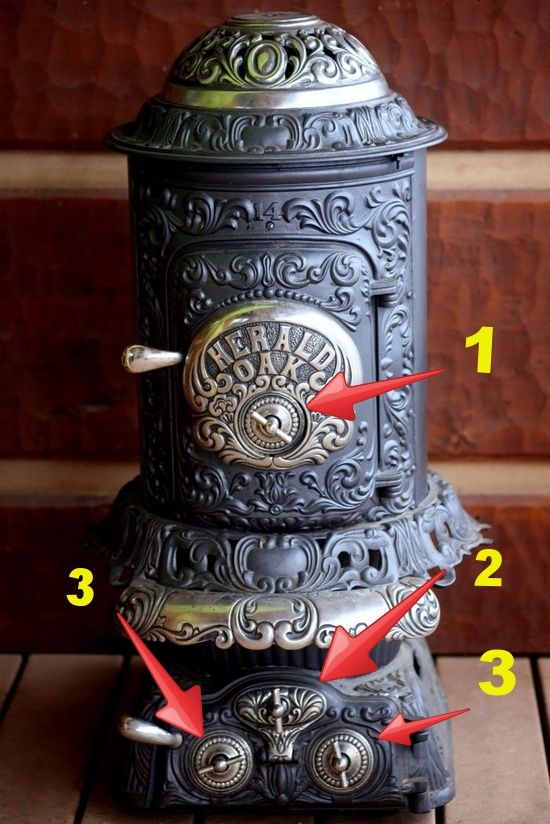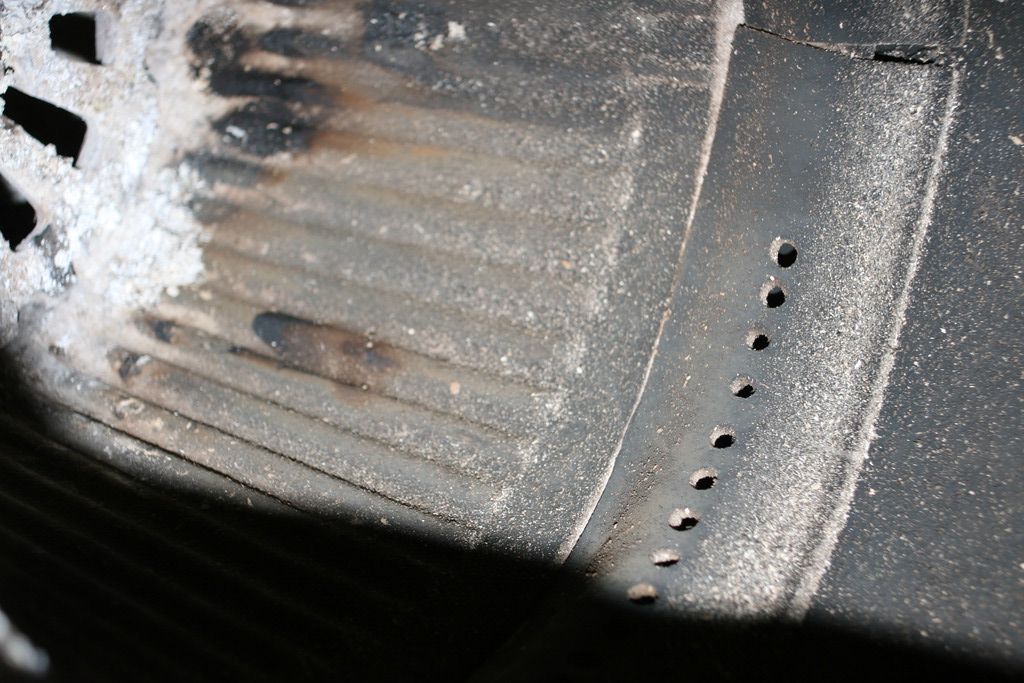I've just come across a Herald Oak 14, 1904, in rusty but usable condition. If any one could offer some info., I'd definitely appreciate it.
The front ash pan/vent door has 3 vents, two threaded vents and one small door in the middle. What is the purpose of that middle door vent? It also has two dampers, the upper one is a bypass to vent directly out the flue, the other is down at the bottom. It appears to direct air under the pan (I don"t have the stove in front of me, so I'm going on memory), and the ash pan seems to have an air space under it. Does this mean it's a base burner, or is there more to it than that? What does that damper do? Also, there is a perforated ring around the inside that probably needs replacing. Is that used when burning soft coal?
This stove will be my project for the fall and will probably replace my P+B "Big Seven" next winter. From what I've been reading, they (Oaks) are very good stoves. If it's better than my P+B, which is a very simple stove, I'll be extremely impressed. The P+B is my first coal stove, and after a bit of a learning curve, I'm hooked. It is heads and shoulders above the best wood stove.
This new stove looks like I'll have a new learning curve to get past in order to get the most out of it.( Right now I'm trying different size coal and coal combinations to get different burning rates.) Thanks.
Front Vent on Herald Oak 14
- Underdog
- Member
- Posts: 52
- Joined: Thu. Oct. 23, 2014 10:00 am
- Location: New England
- Hand Fed Coal Stove: Herald Oak 14 1904
- Baseburners & Antiques: Herald Oak 14
- Coal Size/Type: nut/ stove Kimmel's
- Other Heating: oil
I use #2 like I'm opening the ash pan door. When you need a momentary influx of air under the fire (without tampering with the draft settings or causing a mess by opening the real ash pan door). You can see a lot thru there and tell if you did a good job of shaking down the fire. Post some pictures when you get a chance. 

- Sunny Boy
- Member
- Posts: 25724
- Joined: Mon. Nov. 11, 2013 1:40 pm
- Location: Central NY
- Hand Fed Coal Boiler: Anthracite Industrial, domestic hot water heater
- Baseburners & Antiques: Glenwood range 208, # 6 base heater, 2 Modern Oak 118.
- Coal Size/Type: Nuts !
- Other Heating: Oil &electric plenum furnace
Very pretty stove underdog.
Is that #2 middle door for grate shaker access?
And, is that some type of slide control near the top right side of the barrel's front casting, just under the bonnet edge , or a shadow line?
Paul
Is that #2 middle door for grate shaker access?
And, is that some type of slide control near the top right side of the barrel's front casting, just under the bonnet edge , or a shadow line?
Paul
-
mcgrath
- New Member
- Posts: 9
- Joined: Thu. Feb. 12, 2015 8:06 am
- Location: Maine
- Hand Fed Coal Boiler: P&B "Big Seven" pot belly
- Other Heating: Wood
Thanks for the reply. It will be about 1 month before I have possession of the stove, but I'll definitely post a "before and after shot". Right now it looks like the photo, only rusty, very very rusty (more like a burn-barrel than a coal stove). It also seems to be missing some of the lower skirt . It may take a while, but it will be done. I needed a project anyway. Thanks again.
- Underdog
- Member
- Posts: 52
- Joined: Thu. Oct. 23, 2014 10:00 am
- Location: New England
- Hand Fed Coal Stove: Herald Oak 14 1904
- Baseburners & Antiques: Herald Oak 14
- Coal Size/Type: nut/ stove Kimmel's
- Other Heating: oil
The "slide control" near the top right side of the barrel's casting is really a stove bolt holding the tops section together. Nothing there.Sunny Boy wrote:Very pretty stove underdog.
Is that #2 middle door for grate shaker access?
And, is that some type of slide control near the top right side of the barrel's front casting, just under the bonnet edge , or a shadow line?
Paul
No idea what #2 door is really for (I wish I had an owner's manual). I open that door when I need to get a good draft going. The two small primary draft controls are very precise but screw in and out. To avoid the need to screw them in, and screw them out every time you need a rapid change of air flow, instead I just open door #2. You could also open the ash pan door to accomplish this task but that little door seems to do the job. As I mentioned, it is also handy for looking up under the burning coal bed to see if you did a fair job of shaking down an old fire. You could get a poker in there if need be.
For ten years I burned only wood in the stove and only once a year at that. I was frustrated at how poorly it performed. I cursed the ignorance of people 100 year ago on their lack of sophistication (how hard can it be to design a functioning stove). I started researching what I could about the stove this past winter. That is when I found William's videos and realized who the ignorant one was.
Not a base burner. Flue gasses escape directly into the stove pipe (and up the chimney) at the back top of the stove's cylinder. That said you can get the flue temps down pretty low.
Last edited by Underdog on Mon. Mar. 30, 2015 8:41 am, edited 1 time in total.
- Photog200
- Member
- Posts: 2063
- Joined: Tue. Feb. 05, 2013 7:11 pm
- Location: Fulton, NY
- Baseburners & Antiques: Colonial Clarion cook stove, Kineo #15 base burner & 2 Geneva Oak Andes #517's
- Coal Size/Type: Blaschak Chestnut
- Other Heating: Electric Baseboard
Nice looking stove Underdog. Door #2 is what they call a clinker door, it is for breaking up or removing clinkers. My stove has one and even before shaking down, I would poke a rod in there to break them up and then they would go through the circular grates easier. As you have found, it also lets a great deal of air directly under the grates.Underdog wrote: The "slide control" near the top right side of the barrel's casting is really a stove bolt holding the tops section together. Nothing there.
No idea what #2 door is really for (I wish I had an owner's manual). I open that door when I need to get a good draft going. The two small primary draft controls are very precise but screw in and out. To avoid the need to screw them in, and screw them out every time you need a rapid change of air flow, instead I just open door #2. You could also open the ash pan door to accomplish this task but that little door seems to do the job. As I mentioned, it is also handy for looking up under the burning coal bed to see if you did a fair job of shaking down an old fire. You could get a poker in there if need be.
For ten years I have burned only wood in the stove and only one a year at best. I was frustrated at how poorly it performed. I cursed the ignorance of people 100 year ago on their lack of sophistication (how hard can it be to design a functioning stove). I started researching what I could about the stove this past winter. That is when I found William's videos and realized who the really ignorant person was.
Not a base burner. Flue gasses escape directly into the stove pipe (and up the chimney) at the back top of the stove's cylinder. That said you can get the flue temps down pretty low.
Randy
- Underdog
- Member
- Posts: 52
- Joined: Thu. Oct. 23, 2014 10:00 am
- Location: New England
- Hand Fed Coal Stove: Herald Oak 14 1904
- Baseburners & Antiques: Herald Oak 14
- Coal Size/Type: nut/ stove Kimmel's
- Other Heating: oil
I have not really had a chance to use these stove for coal burning. I have chimney issues that need sorted out. Oddly enough when I hired a professional chimney person to quote me a price on some repairs, he offered to do the work for free in exchange for the stove. I'm not sure if I should have taken him up on the offer or not. The photo is not my stove. Just one I found available online.
- Underdog
- Member
- Posts: 52
- Joined: Thu. Oct. 23, 2014 10:00 am
- Location: New England
- Hand Fed Coal Stove: Herald Oak 14 1904
- Baseburners & Antiques: Herald Oak 14
- Coal Size/Type: nut/ stove Kimmel's
- Other Heating: oil
I cannot answer your question about the holes. I do not know why the holes are there along the rim. Good to know another Herald 14. If you want to go in together on a replacement set of grate castings sometime in the future let me know. Mine seem to work fine but I would rather not wait until it was too late.


- Sunny Boy
- Member
- Posts: 25724
- Joined: Mon. Nov. 11, 2013 1:40 pm
- Location: Central NY
- Hand Fed Coal Boiler: Anthracite Industrial, domestic hot water heater
- Baseburners & Antiques: Glenwood range 208, # 6 base heater, 2 Modern Oak 118.
- Coal Size/Type: Nuts !
- Other Heating: Oil &electric plenum furnace
That ring around the top of the firepot, with the row of small holes, looks like the "gas ring" used in the Glenwood # 6 & #8 base heaters.
It preheats, and more uniformly directs secondary air over the top of the fire bed than just a single door mounted secondary air damper.
Since the holes don't appear to be evenly spaced around the firepot like the Glenwoods, I'm not sure how well it would help with burning bit coal.
Paul
It preheats, and more uniformly directs secondary air over the top of the fire bed than just a single door mounted secondary air damper.
Since the holes don't appear to be evenly spaced around the firepot like the Glenwoods, I'm not sure how well it would help with burning bit coal.
Paul


